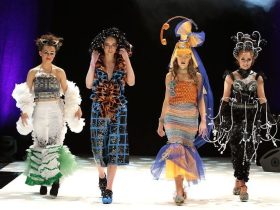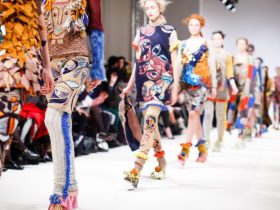In an era where environmental concerns are more pressing than ever, the fashion industry stands at a crossroads, grappling with its impact on our planet. As consumers become increasingly aware of the consequences of fast fashion, the call for sustainable practices has never been louder. But what does sustainability really mean for fashion, and why is it crucial for a thriving future?
This article explores the transformative potential of sustainable fashion, highlighting innovative practices, ethical sourcing, and the role of conscious consumerism. Join us as we delve into how embracing sustainability not onyl benefits the environment but also enriches our wardrobes and connects us to the stories behind the clothes we wear. Together, we can stitch a brighter future for fashion—one that prioritizes our planet and its people.
The Importance of Eco-Friendly Materials in Fashion

The fashion industry has long been criticized for its detrimental impact on the environment, making the shift towards eco-friendly materials not just a trend, but a necessity. By embracing sustainable fabrics such as organic cotton,hemp,and recycled polyester,brands can substantially reduce their carbon footprint and the amount of waste generated. These materials offer a viable alternative to their conventional counterparts by eliminating toxic chemicals and promoting biodiversity. Some benefits of using eco-friendly materials include:
- Reduced Environmental Impact: Sustainable materials have a lower carbon emissions during production.
- Enhanced Durability: Many eco-friendly fabrics are designed to last longer, contributing to a decrease in fast fashion consumption.
- Support for Ethical Practices: sourcing from sustainable suppliers frequently enough promotes fair labor practices.
Moreover, consumers are increasingly seeking brands that align with their values, pushing businesses to prioritize sustainability in their operations. The integration of eco-friendly materials not only cultivates a positive brand image but also fosters customer loyalty in a competitive market. To illustrate the impact these materials can make, here’s a brief comparison of traditional versus eco-friendly materials:
| material Type | Environmental Impact | Longevity | Cost |
|---|---|---|---|
| Conventional Cotton | high chemical usage | Medium | Low |
| Organic cotton | Minimal chemicals | High | Medium |
| Recycled Polyester | Less waste, lower resource input | High | Medium |
Embracing Ethical Production Practices for a Better Tomorrow
In the realm of fashion, embracing ethical production practices is not merely a trend; it represents a profound shift towards sustainability that can shape a better tomorrow. By prioritizing the well-being of our planet and its inhabitants, brands can create a positive ripple effect throughout the industry. consumers are increasingly drawn to companies that demonstrate a commitment to responsible sourcing, fair labor practices, and environmentally-friendly materials.This shift not only enhances brand credibility but also fosters a loyal customer base that values transparency and integrity.
to effectively implement ethical practices, fashion brands can focus on several key areas:
- Supply Chain Transparency: Ensure that every step, from raw material sourcing to finished product, is obvious and traceable.
- Fair Labor Policies: establish guidelines that protect workers’ rights and promote fair wages and safe working conditions.
- Waste Reduction: Adopt circular fashion strategies that minimize waste through recycling and upcycling.
- Eco-Friendly Materials: Utilize organic, biodegradable, or recycled materials to reduce environmental impact.
Investing in these practices can lead to a more sustainable future, where fashion is synonymous with ethical responsibility. Below is a brief comparison of traditional vs. ethical fashion practices:
| Traditional Fashion | Ethical Fashion |
|---|---|
| Mass production with low costs | Small-scale production with fair pricing |
| Environmental degradation | Environmentally sustainable methods |
| exploitation of labor | Fair wages and safe working conditions |
Consumer Awareness and Its Role in Shaping sustainable Trends
consumer awareness is a powerful catalyst in driving sustainable trends within the fashion industry. Today’s shoppers are increasingly informed and concerned about the environmental and ethical implications of their purchases. They actively seek out brands that align with their values, frequently enough favoring those that prioritize eco-friendly materials, fair labor practices, and transparency in their supply chains. As consumers demand accountability, brands are compelled to adapt their practices, leading to innovative solutions like sustainable sourcing, circular fashion, and zero-waste collections.This shift not only supports ethical production but also fosters a culture of sustainability that resonates with the modern consumer.
Moreover, consumer education plays a pivotal role in influencing trends. By promoting awareness around issues such as fast fashion’s impact on the environment and social justice,brands and influencers can inspire a more responsible shopping ethos. Key aspects of this awareness include:
- Understanding supply Chains: Knowing where and how products are made.
- Material Choices: Opting for organic, recycled, or biodegradable materials.
- Longevity over Trendiness: Investing in timeless pieces rather than fleeting styles.
Through collaboration between brands, consumers, and educational initiatives, the fashion industry can transform into a more sustainable landscape, ensuring that the choices made today pave the way for a greener tomorrow.
Innovative Strategies for Sustainable Fashion Brands to Thrive
Embracing sustainability doesn’t just benefit the environment; it can significantly elevate a fashion brand’s market presence and consumer loyalty. By integrating eco-friendly materials such as organic cotton, Tencel, or recycled polyester into their product lines, brands create a tangible connection with environmentally conscious consumers. Moreover, establishing transparent supply chains helps build trust, as transparency in sourcing, production processes, and labor practices resonates with customers seeking ethical choices. Brands can also enhance their appeal by adopting innovative production techniques, such as on-demand manufacturing and zero-waste design, which minimize excess materials and waste.
In addition to these practices, effective marketing strategies that highlight sustainability can draw attention to a brand’s mission. Utilizing social media to share behind-the-scenes processes and customer testimonials can foster a community of engaged consumers. Collaborating with influencers who advocate for sustainable living can amplify outreach efforts and attract a broader audience. Moreover, brands can consider implementing loyalty programs that reward customers for sustainable purchases or participation in eco-friendly initiatives. The following table summarizes potential strategies for fostering sustainability:
| Strategy | Description |
|---|---|
| Eco-friendly Materials | Use sustainable fabrics to reduce environmental impact. |
| Transparent Supply Chains | Share sourcing and production details with consumers. |
| Innovative Production Techniques | Implement methods that reduce waste and excess inventory. |
| Community Engagement | Utilize social media to connect with and involve customers. |
| Loyalty programs | Reward sustainable purchases and eco-friendly actions. |
Future Outlook
As we navigate the complexities of our changing world, it’s clear that sustainability is more than just a trend; it’s an essential pillar for the future of fashion. By prioritizing eco-friendly practices, innovative materials, and ethical production methods, we can create a vibrant industry that respects our planet and its people.Embracing sustainability not only helps reduce our ecological footprint but also fosters creativity and collaboration within the fashion community. As consumers, we hold powerful influence over industry practices, and by supporting sustainable brands, we can drive meaningful change.
In this exciting era of fashion evolution, let’s champion designs that tell stories of resilience and responsibility. Together, we can weave a future where style and sustainability go hand in hand, ensuring that the garments we cherish today do not compromise the beauty of our tomorrow. Thank you for joining us on this journey towards a more sustainable fashion landscape!










Leave a Reply